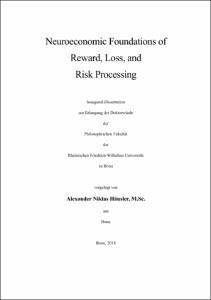Häusler, Alexander Niklas: Neuroeconomic Foundations of Reward, Loss, and Risk Processing. - Bonn, 2019. - Dissertation, Rheinische Friedrich-Wilhelms-Universität Bonn.
Online-Ausgabe in bonndoc: https://nbn-resolving.org/urn:nbn:de:hbz:5-52951
Online-Ausgabe in bonndoc: https://nbn-resolving.org/urn:nbn:de:hbz:5-52951
@phdthesis{handle:20.500.11811/8129,
urn: https://nbn-resolving.org/urn:nbn:de:hbz:5-52951,
author = {{Alexander Niklas Häusler}},
title = {Neuroeconomic Foundations of Reward, Loss, and Risk Processing},
school = {Rheinische Friedrich-Wilhelms-Universität Bonn},
year = 2019,
month = jan,
note = {Together with neuroscientific inventions such as functional magnetic resonance imaging (fMRI), economic and psychological developments in the study of human decision making have led to the formation of neuroeconomics. As part of this research, several aspects of reward, loss, and risk processing have been related to (sometimes irrational) human decision making. The three studies that form the foundation of this doctoral thesis integrated techniques from neuroscience, psychology, and economics to answer specific questions about this relationship.
The first study provides evidence for a common neural currency of reward processing and shows that it exists in the context of money and soccer. The second study implemented fMRI and eye-tracking in two separate experiments to show that reward- and loss-related brain activation is associated with attention distribution (e.g. winning amount vs. winning probability) in risky gambles. The third study presents the neuroeconomic (i.e. neuroscientific, psychological, and economic) associations of real-life stock purchase and extends previous findings of financial risk taking from the laboratory to real life. Using the framework of reward, loss, and risk processing to answer detailed research questions about human decision making, all three studies show the strength of the neuroeconomic approach and add valuable information to our understanding of human behavior.
In the first chapter, the thesis provides background information on the field of neuroeconomics and describes the benefits of the neuroeconomic approach. The second chapter describes the materials and methods used in the three studies. It is followed by chapter three, which summarizes and links the three main publications that I worked on during my doctoral studies. Finally, chapter four consists of a conclusion, as well as an outlook and possible applications of the research findings.},
url = {https://hdl.handle.net/20.500.11811/8129}
}
urn: https://nbn-resolving.org/urn:nbn:de:hbz:5-52951,
author = {{Alexander Niklas Häusler}},
title = {Neuroeconomic Foundations of Reward, Loss, and Risk Processing},
school = {Rheinische Friedrich-Wilhelms-Universität Bonn},
year = 2019,
month = jan,
note = {Together with neuroscientific inventions such as functional magnetic resonance imaging (fMRI), economic and psychological developments in the study of human decision making have led to the formation of neuroeconomics. As part of this research, several aspects of reward, loss, and risk processing have been related to (sometimes irrational) human decision making. The three studies that form the foundation of this doctoral thesis integrated techniques from neuroscience, psychology, and economics to answer specific questions about this relationship.
The first study provides evidence for a common neural currency of reward processing and shows that it exists in the context of money and soccer. The second study implemented fMRI and eye-tracking in two separate experiments to show that reward- and loss-related brain activation is associated with attention distribution (e.g. winning amount vs. winning probability) in risky gambles. The third study presents the neuroeconomic (i.e. neuroscientific, psychological, and economic) associations of real-life stock purchase and extends previous findings of financial risk taking from the laboratory to real life. Using the framework of reward, loss, and risk processing to answer detailed research questions about human decision making, all three studies show the strength of the neuroeconomic approach and add valuable information to our understanding of human behavior.
In the first chapter, the thesis provides background information on the field of neuroeconomics and describes the benefits of the neuroeconomic approach. The second chapter describes the materials and methods used in the three studies. It is followed by chapter three, which summarizes and links the three main publications that I worked on during my doctoral studies. Finally, chapter four consists of a conclusion, as well as an outlook and possible applications of the research findings.},
url = {https://hdl.handle.net/20.500.11811/8129}
}






